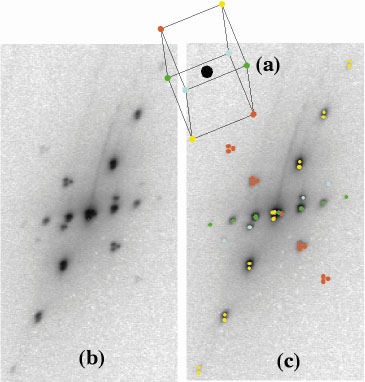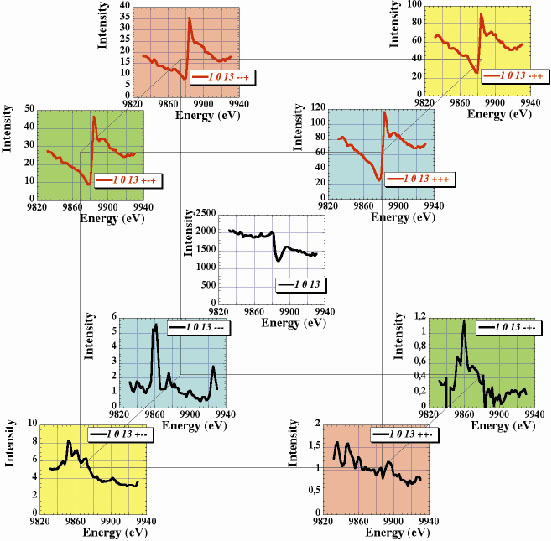- Home
- Users & Science
- Scientific Documentation
- ESRF Highlights
- ESRF Highlights 2001
- Collective Atom Dynamics
- Anomalous and High-resolution Diffraction Study of the Charge-Density-Wave for the Compound (TaSe4)2I
Anomalous and High-resolution Diffraction Study of the Charge-Density-Wave for the Compound (TaSe4)2I
The physics of low-dimensional metals is the subject of active research due to their very peculiar electronic and elastic properties. The low dimensionality in the metal-metal interactions strongly enhances the electron-electron, electron-phonon (e-ph) and spin-phonon coupling strengths which, under suitable conditions of temperature, pressure or magnetic field, result in the partial or complete condensation of the free carriers by formation of a charge (and/or spin) density wave C(S)DW. A structural transition, the so-called Peierls transition, occurs when a phonon mode (which is strongly affected by the e-ph coupling) condenses below T = TP, thus inducing below this temperature a structural modulation with the same period as the CDW. While other CDW systems are now well characterised, the detailed nature of the e-ph coupling mechanism in (TaSe4)2I was not fully understood, and has been the motivation for the present study.
(TaSe4)2I, crystallises in the tetragonal I422 space group and consists of infinite covalently bonded (TaSe4)n chains along the c-axis, with an average number of conduction electrons per Ta equal to 0.5. A first diffraction experiment, conducted on BM2, the French CRG D2AM beamline, has allowed us to characterise the domain structure in this compound. The low-temperature charge modulation gives rise to 8 first-order satellites (Figure 83) around each reflection, at q = (±0.05, ±0.05, ±0.08). This is consistent with previous observations and confirms that the modulation has a strong acoustic character, i.e. with all atoms moving along the same direction with the same amplitude, and that the displacements are mainly perpendicular to the chain axis (acoustic shear modes). Furthermore, the high-resolution diffraction images show a splitting of all reflections, which demonstrates that the sample consists of 4 degenerate domains, each with a different modulation wavevector, the splitting being due to a monoclinic distortion.
 |
Fig. 83: (a) Reciprocal space sketch of the 8 satellites around each reflection. (b) High-resolution diffraction image showing the [16 4 4] reflection and its satellites. (c) Satellite indexation on the image. Note the splitting of all reflections, due to the domain structure. Up to third-order satellites have been observed. |
In a second, anomalous X-ray diffraction experiment, diffracted intensities were recorded as a function of the incident photon energy around the Ta LIII absorption edge in order to determine specifically the displacements of the tantalum atoms. On intensities recorded for [hkl] reflections with l = 4n + 1 (Figure 84), only diffraction satellites with qz = +0.08 showed a notable anomalous signal, while reflections with l = 4n 1 showed a strong anomalous signal for qz = -0.08 satellites. This behaviour is consistent with optic-like Ta displacements along the metallic chains corresponding to a LLSS pattern of long and short in-chain Ta-Ta distances (Ta-tetramerisation modes). Thus, the overall Ta displacements are the sum of (i) acoustic displacements perpendicular to the chains, of amplitude ~ 0.1 Å, and (ii) tetramerisation displacements along the chains, of amplitude ~ 0.015 Å.
 |
| Fig. 84: Anomalous variations (corrected for the absorption) around the Ta LIII edge of the [1 0 13] reflection and its 8 satellites. Only the four upper satellites (red curves), with qz = +0.08, exhibit a strong anomalous variation, demonstrating a tetramerisation of the Ta atoms. |
These results strongly support a previously proposed scenario [1], in which the conduction electrons couple to zone centre optic modes and induce the above LLSS pattern along each chain. These modes in turn interact with long-wavelength acoustic shear modes leading to the condensation of a long-wavelength modulation of mixed acoustic-optic character.
References
[1] J. E. Lorenzo et al., J. Phys. Condens. Matter 10, 5039 (1998).
Principal Publication and Authors
V. Favre-Nicolin (a,b), S. Bos (a), J.E. Lorenzo (a), J-L. Hodeau (a), J-F. Berar (a), P. Monceau (c), R. Currat (d), F. Levy (e) and H. Berger (e) Phys. Rev. Lett. 87, 15502 (2001).
(a) Laboratoire de Cristallographie-CNRS, Grenoble (France)
(b) ESRF
(c) CRTBT-CNRS, Grenoble (France)
(d) ILL
(e) EPFL, Lausanne (Switzerland)
| <<< Previous | Contents | Next >>> |
| last modified: 4 April, 2003 by webmaster@esrf.fr | |



